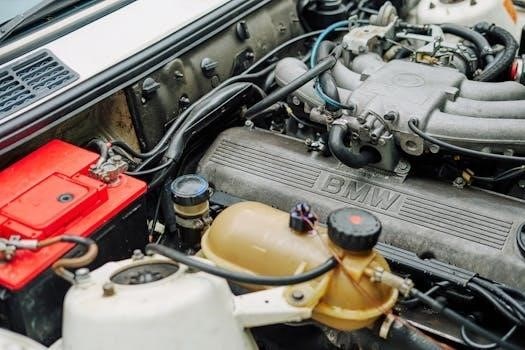
ford f53 chassis manual
Ford F53 Chassis Manual Overview
The Ford F53 chassis is a popular platform for motorhomes, and manuals provide crucial information. These documents range from basic owner guides to detailed service and repair instructions, essential for maintenance and troubleshooting.
Types of Manuals Available
Several types of manuals cater to Ford F53 chassis needs. First, there are owner’s manuals, which cover basic operation, weekly checks, and fluid information. Then, service and repair manuals delve into detailed repair procedures, wiring diagrams, and troubleshooting. Workshop manuals focus on lubricants, fluid specifications, and periodic service intervals. These manuals are crucial for proper care and maintenance of the chassis, ranging from simple tasks to complex repairs. Some sources offer specific manuals for roadside repairs as well. Digital versions, like PDFs, are also available, offering easy access on various devices. The variety ensures users find the right information for their needs, whether routine upkeep or intricate fixes.
Availability of Online Manuals
Finding Ford F53 chassis manuals online is relatively easy thanks to numerous digital resources. Many websites offer downloadable PDFs of owner’s, service, and workshop manuals. These digital formats provide convenient access on computers, tablets, and smartphones. Online retailers and marketplaces often list both new and used manuals, including factory dealership versions. Some sites even provide instant access to detailed repair guides, wiring diagrams, and troubleshooting charts. The availability of cloud-based manuals further enhances accessibility. However, it’s crucial to verify the authenticity and reliability of these sources to ensure the information is accurate and up-to-date. This wealth of online resources makes maintaining a Ford F53 chassis more manageable.

Service and Repair Manuals
Service and repair manuals for the Ford F53 chassis offer detailed procedures, wiring diagrams, and specifications. These are crucial for comprehensive maintenance and troubleshooting, ensuring effective repairs.
Detailed Repair Procedures
Detailed repair procedures within the Ford F53 chassis manuals offer step-by-step guidance for various maintenance tasks. These procedures are essential for both DIY enthusiasts and professional mechanics. They cover everything from simple component replacements to complex system overhauls. These manuals often include specific torque specifications, part numbers, and detailed diagrams, ensuring accurate and safe repairs. The information is typically based on original manufacturer data. Repair procedures help with tasks like changing fluids, replacing brakes, or diagnosing engine issues. With these detailed instructions, mechanics can effectively troubleshoot and fix problems, ensuring the F53 chassis operates reliably and efficiently. This level of detail is invaluable.
Wiring Diagrams and Specifications
Wiring diagrams and specifications are crucial components of Ford F53 chassis manuals, essential for electrical troubleshooting and repairs. These diagrams provide a visual representation of the vehicle’s electrical system, showing how different circuits and components are interconnected. They allow technicians to trace wiring paths, identify faulty connections, and understand the system’s overall layout. Detailed specifications within these manuals include voltage requirements, amperage ratings, and sensor information, providing crucial data for accurate diagnostics and repairs. Having access to precise wiring diagrams and specifications helps in addressing issues like faulty lights, malfunctioning sensors, and electrical system failures efficiently. They are an indispensable resource for both experienced and novice technicians working on the F53 chassis.
Troubleshooting Charts
Troubleshooting charts within Ford F53 chassis manuals are invaluable tools for diagnosing problems. These charts offer a structured approach to identifying the root causes of various mechanical and electrical issues. They typically present a series of questions or symptoms, leading the user through a logical process to pinpoint the problem. By following the chart’s guidance, technicians can quickly narrow down potential causes, saving time and effort. These charts often include common problems and their possible solutions, covering a wide range of scenarios from engine troubles to chassis malfunctions. They act as a quick reference guide, making it easier to understand and resolve issues systematically. Troubleshooting charts greatly assist in efficient vehicle maintenance and repair.

Owners Manuals
Ford F53 owners manuals provide essential information for everyday operation and maintenance. These manuals cover routine checks, fluid specifications, and basic upkeep procedures for the chassis.
Weekly Checks and Maintenance
Regular weekly checks are vital for maintaining the Ford F53 chassis’s reliability and safety. Owners should inspect fluid levels, including engine oil, coolant, and brake fluid, ensuring they are within the specified ranges. Tire pressure should be checked and adjusted to the recommended levels to ensure optimal handling and tire wear. It’s essential to examine the chassis for any visible signs of damage or leaks, addressing them promptly to prevent further issues. Checking the functionality of lights and signals is crucial for safe operation. Additionally, a quick visual inspection of the undercarriage can reveal any loose components or potential problems. Following these weekly checks helps ensure the F53 chassis remains in good working order. This proactive approach aids in preventing minor issues from escalating into major repairs, extending the lifespan of the chassis and enhancing the overall driving experience.
Fluid and Lubricant Information
The Ford F53 chassis manual provides essential details regarding the correct fluids and lubricants needed for optimal performance. It specifies the types and grades of engine oil, transmission fluid, coolant, and brake fluid that are compatible with the chassis. This information is crucial to prevent damage and ensure the longevity of the components. The manual also includes details on recommended lubricants for chassis components such as steering and suspension systems. Understanding the correct fluid capacities is important for proper maintenance and avoiding overfilling or underfilling. Using the wrong fluids or lubricants can lead to premature wear, malfunctions, and potentially costly repairs. Always refer to the manual to ensure the right products are used to maintain the F53 chassis properly.

Workshop Manuals
Workshop manuals offer in-depth technical details for the Ford F53 chassis. These manuals are crucial for mechanics and those performing major repairs, with detailed specifications and procedures.
Lubricants and Fluid Specifications
The Ford F53 chassis workshop manuals provide precise details on lubricants and fluid specifications. These specifications are vital for maintaining the chassis’s performance and longevity. The manuals detail the correct types of engine oil, transmission fluid, coolant, brake fluid, and power steering fluid, including the required viscosity and capacity. Using the correct fluids is crucial to prevent damage and ensure optimal operation. Specifications include information for the rear axle lubricant, which is often synthetic. Periodic fluid changes at recommended intervals are also outlined in the manual. These specifications help to ensure that the vehicle operates smoothly and reliably. Regular checks and adherence to the fluid guidelines will contribute to the longevity and performance of the F53 chassis. Proper lubrication is fundamental for all moving parts of the chassis. This information is found in the workshop manuals.
Periodic Service Intervals
The workshop manuals for the Ford F53 chassis outline specific periodic service intervals. These intervals are critical for maintaining the chassis’s reliability and performance. The manuals specify how often to perform tasks such as oil changes, filter replacements, and fluid checks. Major periodic service is typically recommended every two years or after 30,000 kilometers. These intervals vary based on driving conditions and vehicle usage. The manual provides detailed checklists and procedures for each service interval. Adhering to these intervals ensures that the vehicle operates safely and efficiently. Proper maintenance at these intervals will prevent major issues. The manual may also include intervals for more in-depth services, such as transmission and rear axle maintenance. Following these guidelines will contribute to a longer lifespan for the chassis. Consult the manual for precise intervals.

Finding Manuals
Ford F53 manuals can be found at authorized service centers or through online retailers. These sources provide access to both printed and digital versions of the manuals.
Authorized Ford Service Centers
Seeking assistance from authorized Ford service centers is a reliable way to obtain accurate and up-to-date manuals for your F53 chassis. These centers often have access to the latest versions of service, repair, and owner’s manuals directly from the manufacturer. Furthermore, they can provide expert advice and support, ensuring you get the correct manual for your specific model year. Utilizing these centers guarantees that the information you receive is precise and dependable, aligning with Ford’s official guidelines. They can also assist with any questions you have about the manuals or the vehicle itself. It’s a great option for those seeking professional guidance and authentic resources.
Online Retailers and Marketplaces
Various online retailers and marketplaces offer a wide selection of Ford F53 chassis manuals, catering to different needs and budgets. Platforms like eBay and specialized automotive websites often list both new and used manuals, including service, repair, and owner’s versions. When purchasing online, it’s crucial to verify the seller’s credibility and carefully check product descriptions to ensure compatibility with your specific F53 model year. Digital versions, often available as PDFs, provide convenient access, while printed manuals offer a tangible resource. Be aware that prices can vary significantly, so comparison shopping is advisable to find the best deal. These sources offer a convenient way to acquire manuals, but caution is needed to confirm their reliability and accuracy.